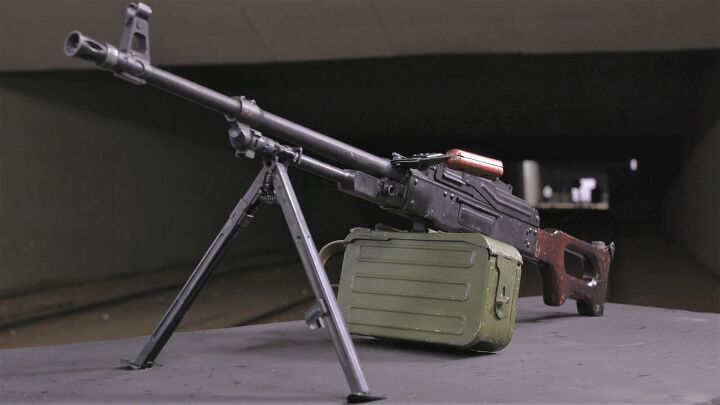The History of PKM, the Most Common Machine Gun In the World. Part 6

In Part 1 of this article, I wrote about the beginning of the Kalashnikov machinegun story, Part 2 was dedicated to the bureaucratic hoops he initially had to jump through, Part 3 described the technical triаls and competition between the Kalashnikov and his rivals, Nikitin and Sokolov. Part 4 was about the troop trials. Part 5 outlined the final results of all the tests.
As I mentioned in the previous article, the big conference at the Small Arms Research Institute in Klimovsk was organized with only one purpose - to decide, which machinegun would be formally accepted into service.
The people in charge decided that if they kept Kalashnikov out of the loop, Nikitin would have no competition while presenting his case. By sheer luck, on the day of the conference, Kalashnikov was in Moscow, only an hour's drive from Klimovsk, but there wasn’t much he could do.
Kalashnikov’s old friend Deikin was there for him once again. He sent the car with a driver to take Kalashnikov to Klimovsk and started making calls. Within an hour Kalashnikov arrived in the city, but he still did not have a pass to enter a highly secretive government facility.
But Deikin always had a plan. He talked to his friends at the ammunition factory that was (and still is) right next to the Small Arms Research Institute. The military officer who was attached to the quality control department quickly dug a hole under the fence that separated the ammunition factory and the Small Arms Research Institute.
Kalashnikov entered the ammunition factory through their checkpoint. From there, he and his assistant crawled under the fence to get into the territory of the Small Arms Research Institute. He made it just on time, at 9.55, entering the conference hall, out of breath, wearing a suit that was covered in mud and dirt.
At 10.00, the conference began. The first to talk were proponents of Nikitin’s machine gun. They planned to win using the Soviet version of a well-known tactic known as “Death by PowerPoint”.
For hours, there was nothing but countless tables and slides, and one talked about troop trials. After lunch, the military officers had a chance to speak up.
They talked about positive experiences with the Kalashnikov machine gun, and after a few speeches, Kalashnikov had a chance to make his pitch. But instead, he sent his assistant, Livady, who was a part of the engineering team.
Livady was young and nervous and didn’t have a speech prepared. So instead of slides and tables he just talked about how the soldiers genuinely liked the Kalashnikov GPMG, describing all the experiences he had during trials, with soldiers preferring Kalashnikov’s machine gun at every opportunity.
After that heartfelt speech, Nikitin took the stand. During his presentation, he managed to mess up the disassembly and reassembly of his machine gun. His team members came to the rescue, but that really didn’t look good.
Finally, Kalashnikov came to the stand with his pitch. He spoke for ten minutes, talking only about his gun and not badmouthing the competitor. When the speech seemed to be over, he put the gun case on the table, opened it, and continued:
"A weapon designer must care about the soldier, first and foremost. PK machine gun is not light by any means. The lighter the weapon, the easier it is for a soldier.
Our team thought of it, and today, for the first time, we are presenting a modernized PK machinegun that we developed in the last few weeks. It is 1.5 kg lighter than the prototype that was tested during the trials.
If you formally accept PK into service, I promise you, we will reduce the weight to 7.5 kg."
It was the first time Kalashnikov showed the prototype of the GPMG that would later become known as PKM. While the machine guns used in trials had a milled receiver, this machine gun had a stamped receiver, making it lighter and cheaper to produce.
The members of the committee started coming to the table to check out the new prototype. No one expected that Kalashnikov would start modernizing his machine gun even before it was formally adopted by the army.
Later on, there were a few more speeches, the head of the committee mentioned that around 5 million USD was already spent on Nikitin’s machine gun, but he didn’t convince anyone.
The three-star general stood up and said:
"We are convinced Kalashnikov machine gun is better than Nkitin’s machine gun. It is simpler, more reliable and soldiers would like it more. We will stand by this decision anywhere, at any level of the government... That’s it. We are leaving."
The conference was over. Kalashnikov and his team still had some explaining to do to the security staff of the facility, but that wasn’t important anymore. They won. On October 20, 1961, PK was formally adopted by the Soviet army.
Now you can find PKMs almost anywhere in the world, used by rebels and special units, on pickup trucks and tanks, on ships, and remote-controlled weapon stations, and no one remembers how it came to be.

Vladimir Onokoy is a small arms subject matter expert and firearms instructor. Over the years he worked in 20 different countries as a security contractor, armorer, firearms industry sales representative, product manager, and consultant. His articles were published in the Recoil magazine, Small Arms Review, Small Arms Defence Journal, and Silah Report. He also contributed chapters to books from the "Vickers Guide: Kalashnikov" series. Email: machaksilver at gmail dot com. Facebook: https://www.facebook.com/Vladimir-Onokoy-articles-and-videos-about-guns-and-other-unpopular-stuff-107273143980300/ Instagram: https://www.instagram.com/vladonokoy/ YouTube: https://www.youtube.com/user/machaksilver
More by Vladimir Onokoy



























Comments
Join the conversation